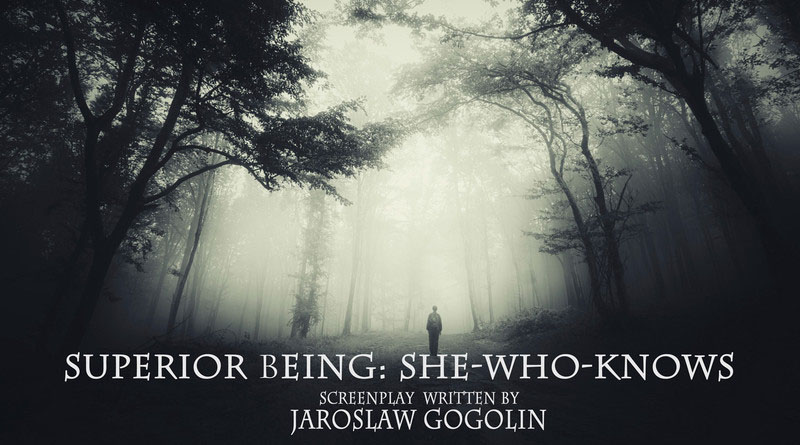Superior Being: She Who Knows | Screenplay

Written by Jaroslaw Gogolin | Reviewed by Sayantan Mukherjee An elderly lady walks through the empty streets of Poland. She wears modest clothes; her posture is stooped and she carries two plastic bags with her. It is early night but the streets are almost empty and a fog is slowly settling in. As she turns a corner, we see three teenage boys - the only other humans in the street except her. The boys are smoking and busy with themselves as the elderly lady tries to walk past them. When suddenly, the boys turn and block her path. One of the boys threaten her for money. The lady looks up, but her eyes gaze past the boys and settles at the end of the road. She pulls out a bouquet of flowers and puts out her hand towards the emptiness. The confused teenagers look back and find a man watching them; his features indistinguishable in the fog. Leaving the lady aside, the boys charge after this shadow with weapons but as they draw nearer to him, it becomes clear that this is not a human being. But it is already too late. Minutes later, we find the elderly lady walking back home and the teenagers lying on the street, gruesomely decapitated. A Successful Set-Up Jaroslaw Gogolin sets up his first sequence-to instantly draw his audience into the action. The mood is set and the monster is established but the stakes are vaguely realized. We don’t know whether to root for the monster or be afraid of it; and we are curious as to how it is placated with a bouquet of flowers. All successful films have to capture its audience’s attention from the beginning and set-up the plot for an interesting journey ahead and here, Jaroslaw has us hooked from the get-go. The story The elderly lady who manages to walk away with help from the monster is Sara Goldberg, a retired professor of Biology. Her life-story becomes the centerpiece henceforth as we delve into her childhood and unravel the dark secrets she has come across and been accomplice to all her life. Sara first meets the monster when she is 6 years old, living with her family in Poland in the 1930s. The monster is her protector, a being from the forest who was drawn to young Sara and her bouquet of wild flowers when she was lost in the woods. It seemingly decides that Sara is a special human and has a a higher purpose. From this point, we are led into different parts of Sara’s life – from her childhood with her family to her adolescence in the concentration camp and her adulthood as a professor of Biology later on. However, even though the story starts with Sara Goldberg and focuses on her life for the most part, the recurring motif which holds it together would be this unnamed forest monster. This is a being which will keep on appearing through Sara’s life and although Sara might be our guiding light through the beginning; she will not be the last one to hold the torch. The Violence The story has a lot of violence from the very start but they always serve an important purpose of driving the narrative forward. Although the death-count ramps up toward the end, it is Sara’s adolescence in the concentration camp which triumphs as the most disturbing. We find Sara living with other Jewish prisoners in the camp, her parents separated from her, likely dead. Sara meets different monsters in here from what she is used to; and these monsters are not benevolent to her. For the first time, the film focuses on real world monsters and the horrifying tales of loss in this section are hard-hitting and nauseating. Script to Film This would be a fantastic project to turn into a film. The elements of mystery, fantasy, history and even biological science in the later parts would make for an enriching and highly interesting feature film. Mostly fantasy films have a tendency to become too distanced from reality. The relatability quotient of such films is stretched thin and thus, the audience is mostly alienated from the content. Superior Being: She Who Knows would serve as departure from this monotonous depiction of fantastical stories and can easily garner interest from a varied audience. The Philosophy The perception of what is good and what can be considered evil are quite unclear once the chips are down. The effects of faith, nature and nurture usually build our baseline personality from which we see the rest of the world. In this screenplay, Jaroslaw shows us a monster that kills with a definite and streamlined purpose behind its actions. Most likely, it doesn’t existentially think about its actions like a human. Similarly, we see the deplorable actions of the Nazis through Sara’s childhood and we find a similar lack of valid reasoning behind their behavior as well. A particularly gut-wrenching scene is when two prisoners in the camp argue about the existence of God and whether he truly deserves to be prayed to. Where was God when millions of Jewish families were being separated forcibly and where was He when innocent children were killed. Praying to an entity which hasn’t helped them in the slightest would be foolish and a prisoner intends to pray to the Nazis instead- a real-life existing entity that is clearly evil; but at least it would ensure their prayers are being heard. In conclusion, Jaroslaw Gogolin’s Superior Being: She Who Knows is an excellent case-point for an expansive but thoughtful screenplay which is ready to be transformed for screen.


